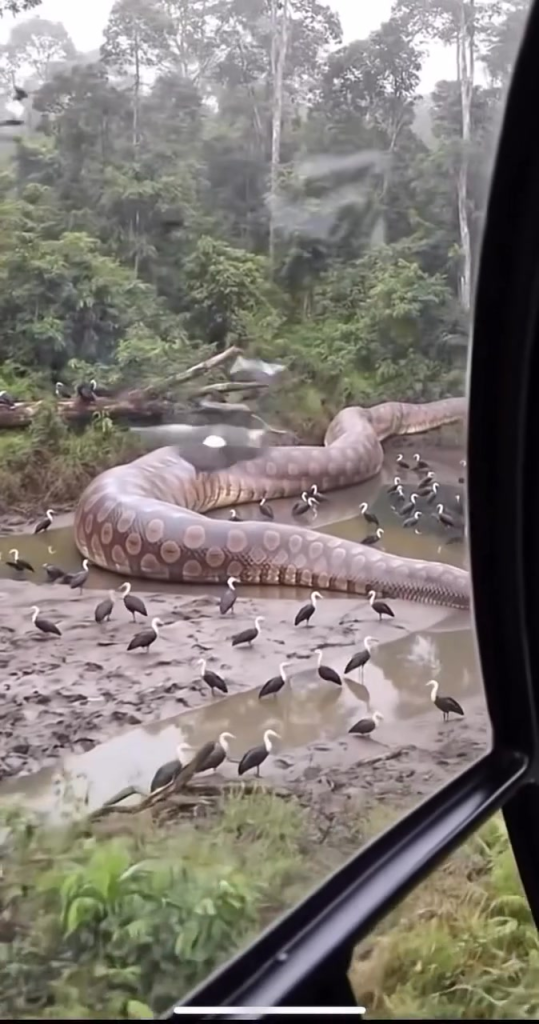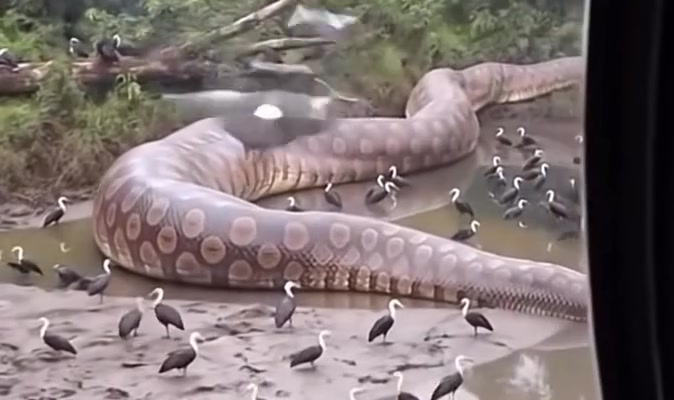The internet thrives on moments of shock, awe, and curiosity. In recent years, no platform has fueled this phenomenon more than TikTok, where short clips can captivate millions in mere hours. Among these viral sensations, one video stands out for its sheer audacity: a clip claiming to show the world’s largest anaconda devouring a horse whole.
From the very first second the footage appeared online, it sparked immediate debate. Could a snake—even one as legendary as the green anaconda—really consume such a massive animal? Or was this just another carefully crafted illusion, designed to prey on the public’s fascination with extremes of nature?
As the video spread like wildfire across social media platforms, viewers were divided into two camps: those who swore it was undeniable proof of nature’s darkest realities, and those who suspected digital trickery. The controversy turned a short, grainy clip into a global talking point, forcing scientists, animal experts, and curious viewers alike to weigh in.
This article dives deep into the story behind the viral sensation, exploring not only the biology of giant snakes but also the psychology of viral media, the myths surrounding anacondas, and the cultural obsession with fear-inducing wildlife encounters. By the end, one question remains: was this a case of nature pushing past its limits, or humanity pushing the boundaries of believability?

The Video That Stopped Viewers in Their Tracks
The clip that set the internet ablaze was brief but unforgettable. Marketed with captions like “The Biggest Snake Ever Recorded” and “Anaconda Swallows Horse Whole”, the video seemed designed to shock.
In the footage, a massive serpent is shown coiling its muscular body around a large, horse-shaped figure. As the reptile contracts, the prey appears trapped in a death embrace. The climax comes as the snake seemingly begins the process of swallowing its catch—its mouth stretching to impossible dimensions.
For viewers unfamiliar with snake behavior, the clip felt like a nightmare brought to life. Horses are symbols of strength, freedom, and size, and the idea of such a majestic creature being consumed alive by a reptile struck a chord of horror.
Yet even as some gasped in disbelief, others raised eyebrows. Was the prey truly a horse? Could a snake’s physiology even allow for such a feat? The mystery only deepened as the video spread across Twitter, Facebook, Instagram, and TikTok, each share adding new speculation.
Anacondas: Nature’s Giant Serpents
To understand the plausibility of the video, one must first explore the biology of the anaconda.
Species and Habitat
The green anaconda (Eunectes murinus), native to South America, is one of the largest snakes in the world. Found primarily in swamps, rivers, and wetlands, these reptiles can reach lengths exceeding 20 feet and weigh over 200 pounds.
Hunting Style
Unlike venomous snakes, anacondas are constrictors. They rely on stealth and raw muscle strength to ambush prey, coil around it, and squeeze until suffocation occurs. Once the animal is subdued, the snake begins the slow process of swallowing it whole, aided by flexible jaw ligaments and powerful digestive enzymes.
Diet in the Wild
Their diet is diverse, ranging from fish and birds to mammals such as capybaras, wild pigs, deer, and occasionally caimans. Reports even exist of anacondas attempting to take down jaguars—although such encounters are rare and risky.
Biological Limitations
Despite their formidable size, anacondas are bound by physical limitations. Scientific studies show that snakes generally consume prey weighing up to 25–30% of their body mass. For even the largest female anacondas, this might include a deer or capybara—but not a full-grown horse, whose weight averages between 900 and 1,200 pounds.
This reality casts immediate doubt on the viral video. No matter how large an anaconda grows, swallowing and digesting an animal as tall, wide, and heavy as a horse remains biologically implausible.
Why People Believed the Video
If science clearly shows that a horse would be impossible prey, why did so many believe the clip?
The Power of Precedent
Real-world encounters with giant snakes fuel public imagination. Documented cases exist of pythons and anacondas swallowing prey such as deer, goats, or even alligators. Disturbing images of snakes with grotesquely distended bodies have circulated for decades. For viewers already aware of these incidents, the leap to imagining a horse wasn’t entirely unthinkable.
Clever Filming and Editing
Camera angles, lighting, and selective framing can drastically alter perception. A smaller animal—like a deer or wild boar—could be positioned or edited to look larger, giving the illusion of horse-sized prey. Combined with sensational captions, the video tapped into primal fears before skepticism could set in.
Viral Psychology
Humans are wired to respond strongly to fear and awe. A clip suggesting a predator capable of devouring an animal as iconic as a horse triggers deep emotional responses, making people more likely to share it before verifying its authenticity.
Real-Life Examples of Giant Snake Meals
While horses are out of the question, anacondas and pythons are still capable of astounding feats.
- Deer Consumption: Several documented cases show large snakes swallowing deer whole. In one instance, a Burmese python in Florida was discovered after consuming a deer nearly equal to its own body mass.
- Caiman Encounters: In the wetlands of Brazil, researchers have witnessed anacondas overpowering caimans, demonstrating their role as apex predators.
- Wild Boars: Villagers in rural South America have reported anacondas preying on wild boars, often leaving the snake immobilized for days as it digests the massive meal.
These examples highlight the remarkable capabilities of giant snakes—but also their limits. They prey on animals within their ecological niche, not towering herbivores like horses.
The Role of Social Media in Wildlife Myths
The spread of the anaconda video is a case study in how social media shapes perceptions of nature.
Sensationalism Over Science
Platforms reward engagement, and nothing sparks clicks faster than shock value. A video of a snake eating a deer might go unnoticed, but frame it as a horse and the virality skyrockets.
Misinformation Cycles
Once sensational content circulates, it is difficult to correct. Even when experts weigh in, many users cling to initial impressions. The result is a cycle where myths persist despite evidence to the contrary.
Blurred Lines Between Reality and Entertainment
Wildlife content increasingly blends genuine documentation with staged performances. Some creators use props, CGI, or selective editing to exaggerate reality. While entertaining, this practice risks misleading audiences about animal behavior.
Cultural Fascination with Monster Animals
The video’s popularity also speaks to humanity’s long-standing obsession with oversized predators.
From medieval dragon myths to modern horror films like Anaconda (1997), the idea of giant serpents devouring humans or livestock has been embedded in cultural imagination. These stories often symbolize fear of the unknown—particularly in regions where such creatures lurk just beyond civilization’s edges.
In this sense, the viral TikTok is a modern retelling of an ancient narrative: the monstrous snake threatening humanity’s dominion over nature.
Expert Opinions: Science Weighs In
Herpetologists and wildlife biologists quickly weighed in after the video surfaced. Their consensus was clear: the clip was either staged, digitally manipulated, or misinterpreted.
- On Prey Size: Experts noted that no snake, living or fossilized, has been documented consuming prey as large as a horse.
- On Snake Behavior: Attempting to swallow prey too large could injure or kill the snake. Evolution favors efficiency, meaning snakes rarely waste energy on impossible meals.
- On Viral Myths: Scientists emphasized the importance of critical thinking when consuming wildlife content online.
Final Thoughts: Separating Fact from Fiction
The TikTok clip of an anaconda allegedly swallowing a horse serves as a reminder of both nature’s wonders and the internet’s ability to distort them.
While anacondas are undeniably among the planet’s most extraordinary predators, their power lies in what they can actually do—not in myths of devouring animals far beyond their capabilities. Horses remain firmly outside their dietary range.
What the video truly reveals is not the strength of snakes, but the strength of storytelling in the digital age. By blending real biology with exaggerated claims, content creators exploit our fascination with the extreme.
For viewers, the lesson is clear: admire nature for what it is, not for what myths suggest. Anacondas don’t need embellishment to capture our awe—they are already living reminders of evolution’s ingenuity.




